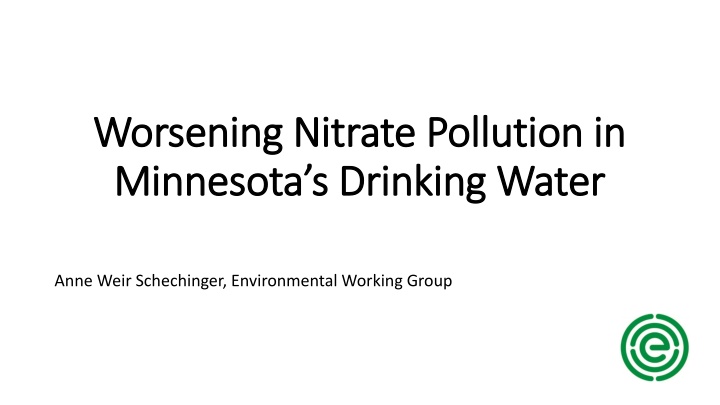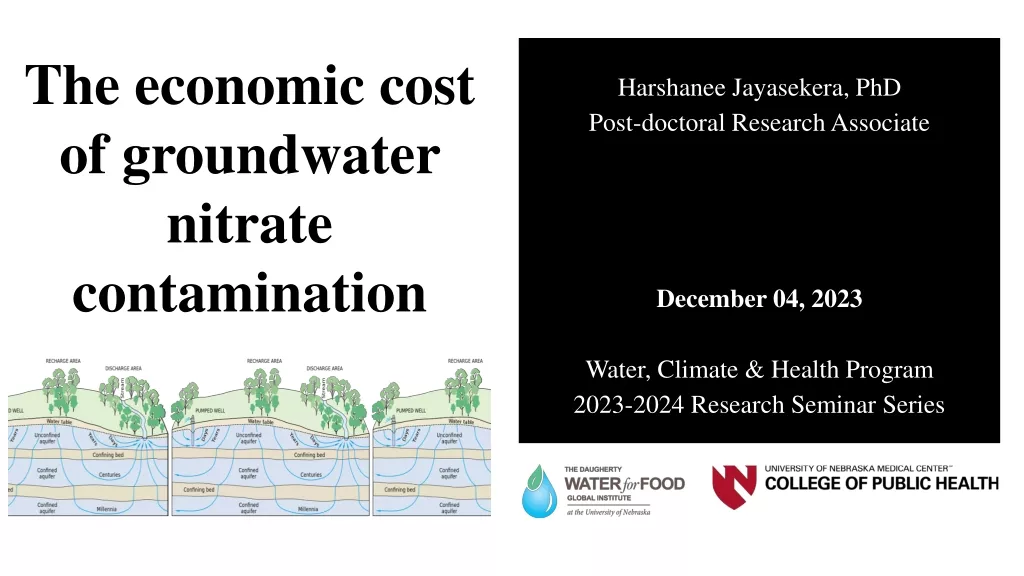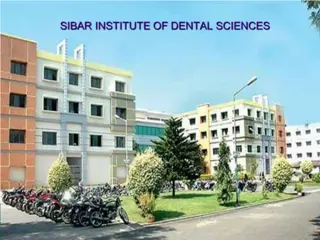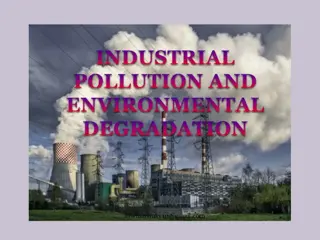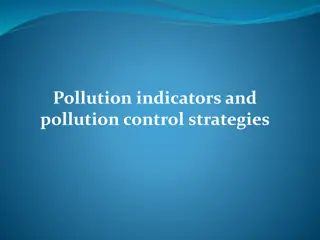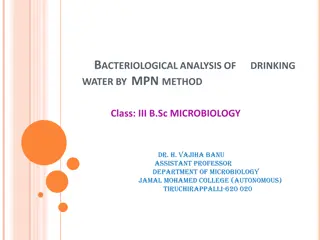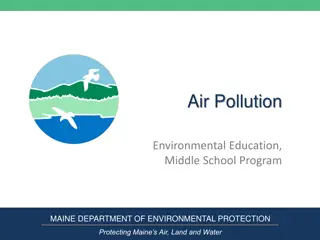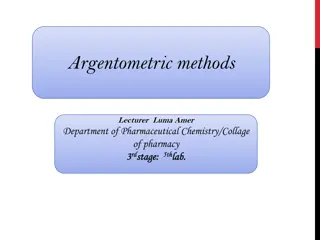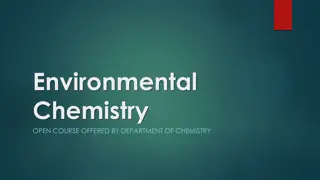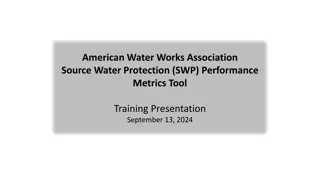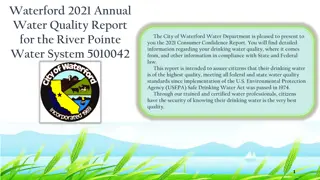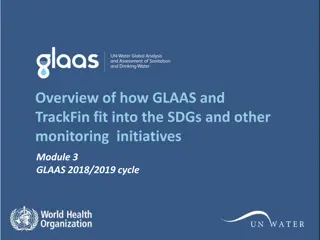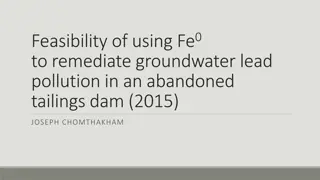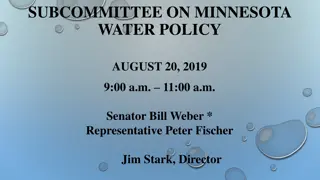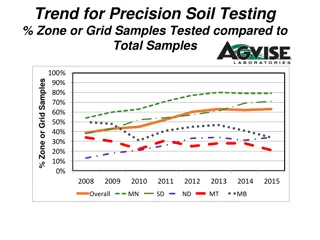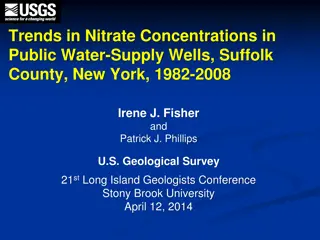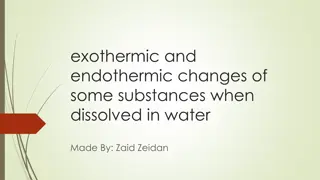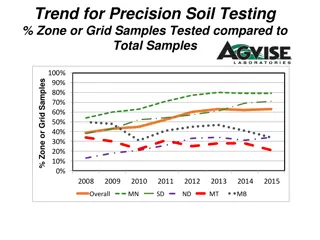Worsening Nitrate Pollution in Minnesota's Drinking Water
Worsening nitrate pollution in Minnesota's drinking water is a growing concern, impacting communities and individuals across the state. Research shows a significant increase in nitrate levels in public water systems, with a disproportionate impact on certain areas. This contamination trend highlights the need for urgent action to address and mitigate the escalating risks to public health and water quality.
Download Presentation

Please find below an Image/Link to download the presentation.
The content on the website is provided AS IS for your information and personal use only. It may not be sold, licensed, or shared on other websites without obtaining consent from the author.If you encounter any issues during the download, it is possible that the publisher has removed the file from their server.
You are allowed to download the files provided on this website for personal or commercial use, subject to the condition that they are used lawfully. All files are the property of their respective owners.
The content on the website is provided AS IS for your information and personal use only. It may not be sold, licensed, or shared on other websites without obtaining consent from the author.
E N D
Presentation Transcript
Worsening Nitrate Pollution in Worsening Nitrate Pollution in Minnesota s Drinking Water Minnesota s Drinking Water Anne Weir Schechinger, Environmental Working Group
Data Evaluated Data Evaluated EWG analyzed MDH finished water nitrate tests for public water systems using ground and surface water. EWG looked at community water systems (CWS) and non-community water systems, but this report only focuses on the trend in CWS. In total, 901 active CWS serving almost 4.4 million people tested for nitrate at least once between 1995 and 2018. This report focuses on CWS that had elevated nitrate tests- i.e. at least 1 nitrate test >= 3 mg/L between 1995-2018.
Methodology Used to Evaluate Nitrate Trends in MN Methodology Used to Evaluate Nitrate Trends in MN Calculated correlation coefficients for each community water system to evaluate if each system s nitrate tests were correlated with year. The correlation coefficient, or r value, calculates the strength of the relationship between the relative movements of two variables. If a system s nitrate tests are positively correlated with year -> nitrate is going up over time. If a system s nitrate tests are negatively correlated with year -> nitrate is going down over time. A few systems also had zero correlation, meaning nitrate stayed the same over time.
Main Findings Main Findings Elevated Nitrate: 115 CWS had elevated levels of nitrate between 1995-2018 (at least 1 test >=3 mg/L). Increasing Nitrate: between 1995-2018, nitrate levels rose in 63% or 72 out of the 115 Minnesota communities with elevated nitrate This contamination impacts over 218,000 Minnesotans. Disproportionate Impact: EWG also found rising nitrate contamination among 67% of the 24 communities that are already facing the worst nitrate drinking water contamination (systems that had at least 1 test >=10 mg/L) This contamination impacts 48,500 Minnesotans.
Community Water System Impacts Community Water System Impacts System Count Systems with worsening N % with worsening N Population with worsening N Community systems >=3 115 72 63% 218,000 Community systems >=10 24 16 67% 48,500
Climbing Contamination Climbing Contamination In the 72 communities with worsening contamination, average nitrate levels increased 61% from 1995-2018. In 1995, average contamination was 2.7 mg/L. By 2009, average contamination had increased to 3.6 mg/L and continued climbing to 4.4 mg/L in 2018. *Spikes in nitrate contamination in the Rock County Rural Water System and the City of Fairmont drove the sharp increase in average contamination in 2016 and 2017.
EWGs Interactive Community Water System Drinking Water EWG s Interactive Community Water System Drinking Water Contamination Map Contamination Map Image of Minnesota divided by counties
Known Private Well Contamination, but More Data Known Private Well Contamination, but More Data Needed to Evaluate Trends in Private Wells Needed to Evaluate Trends in Private Wells Minnesota does not collect, or require private well owners to collect, private well data with same frequency as public well data. The state does not have enough data on private well nitrate contamination for EWG to evaluate trends in private wells. We do know, based on our previous analysis and reporting, that 3,364 private wells in the state have already tested at or above 10 mg/L between 2009-2018 and are unsafe for human consumption. Assuming an average of 3 people per household, this most severe private well contamination already impacts 10,092 Minnesotans. It is likely that nitrate contamination has also increased over time in private wells, since many draw water from the same groundwater sources as community water systems. More data on private wells should be collected, to fully understand trends in private wells and to protect public health.
EWGs Interactive Private Well Drinking Water Contamination Map EWG s Interactive Private Well Drinking Water Contamination Map Image of Minnesota with notations for contamination of private well drinking water
Environmental Justice Implications Environmental Justice Implications Of the 72 Minnesota community water systems with worsening contamination, 61% were in a U.S. Census block group with median household income below the state s average. 51% of all private wells with at least 1 test >=3 mg/L between 2009 and 2018 were in a U.S. Census block group with median household income below the state s average. The University of Minnesota Water Resources Center has conducted studies on the high costs of treating nitrate contaminated drinking water, and our analysis shows that these high costs are falling on many of the Minnesotans who can least afford treatment.
Cost of Nitrate Treatment Cost of Nitrate Treatment According to MDH, 8 Minnesota community water systems installed nitrate treatment between 1994 and 2018. Total capital costs across the 8 systems, not including operating or maintenance costs, were $30.65 million. System Name 2018 Population Served Capital Cost Capital Cost Per Person Adrian 1,211 $934,286 $771 Clear Lake 525 $696,452 $1,327 Edgerton 1,171 $498,204 $425 Ellsworth 462 $629,693 $1,363 Hastings 22,335 $4,230,578 $189 Lincoln-Pipestone Rural Water System 13,644 $2,593,429 $190 Saint Peter 11,784 $21,044,857 $1,786 Sundsruds Court 40 $18,843 $471 Total 51,172 $30,646,342 $599
Statistical Significance Calculated the t statistic and p value for each system to see if the positive/negative correlations were statistically significant. Statistical significance is the likelihood that a relationship between two or more variables is caused by something other than chance. Community systems with worsening nitrate were more likely to be statistically significant than those with nitrate levels that improved. Community system count % of community systems Statistically significant count % of increasing/decreasing that are statistically significant Community systems >=3 with increasing nitrate Community systems >=3 with decreasing nitrate 72 63% 43 60% 40 35% 20 50%
